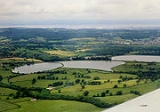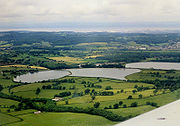
Barrow Gurney Reservoirs
Encyclopedia
Barrow Gurney Reservoirs (also known as Barrow Gurney Tanks or Barrow Tanks) are three artificial reservoirs for drinking water near the village of Barrow Gurney
, which lies southwest of Bristol
, England. They are known by their numbers rather than names.
They are fed by several springs including one which becomes the Land Yeo
. Some of the outfall is also used to feed the river which flows to the Bristol Channel
.
There are three reservoirs in total, one (Tank number three, 60 acres (24.3 ha) to the north of the A38
and two (Tank number one, 25 acres (10.1 ha) and number two, 40 acres (16.2 ha) to the south.
The reservoirs are operated by Bristol Water
. The first opened in 1852 to store the water from the newly finished "Line of Works", but within two years it developed a leak and had to be drained for repair, causing serious disruption to Bristol's water supply. Over the following decades, work was undertaken to improve the water quality. First with sand filters and in 1935 with chlorination
During 1962 maximum output was increased from 26 million impgals (118,198.3 m³) to 31 million impgals (140,928.8 m³) a day by lowering the outlet of the filtered tank and duplicating inlets to the seven filters which received microstrained water.
 The stony banks on all the tanks provide a habitat for sedges.
The stony banks on all the tanks provide a habitat for sedges.
Fishing (under permit) is generally for rainbow
(Oncorhynchus mykiss, formerly Salmo iridia) and Brown trout
(Salmo trutta morpha fario and S. trutta morpha lacustris).
Barrow Gurney
Barrow Gurney is a village and civil parish in Somerset, England, situated in the Unitary Authority of North Somerset on the B3130, midway between the A38 and A370 near the Long Ashton bypass and Bristol Airport, south west of Bristol city centre...
, which lies southwest of Bristol
Bristol
Bristol is a city, unitary authority area and ceremonial county in South West England, with an estimated population of 433,100 for the unitary authority in 2009, and a surrounding Larger Urban Zone with an estimated 1,070,000 residents in 2007...
, England. They are known by their numbers rather than names.
They are fed by several springs including one which becomes the Land Yeo
Land Yeo
The Land Yeo is a small river which flows through North Somerset, England.It rises on Dundry Hill and supplies Barrow Gurney Reservoirs before flowing through various villages to Clevedon where it drains into the Bristol Channel...
. Some of the outfall is also used to feed the river which flows to the Bristol Channel
Bristol Channel
The Bristol Channel is a major inlet in the island of Great Britain, separating South Wales from Devon and Somerset in South West England. It extends from the lower estuary of the River Severn to the North Atlantic Ocean...
.
There are three reservoirs in total, one (Tank number three, 60 acres (24.3 ha) to the north of the A38
A38 road
The A38, part of which is also known as the Devon Expressway, is a major A-class trunk road in England.The road runs from Bodmin in Cornwall to Mansfield in Nottinghamshire. It is long, making it one of the longest A-roads in England. It was formerly known as the Leeds — Exeter Trunk Road,...
and two (Tank number one, 25 acres (10.1 ha) and number two, 40 acres (16.2 ha) to the south.
The reservoirs are operated by Bristol Water
Bristol Water
Bristol Water supplies 300 million litres of drinking water to over 1 million customers in a area centred on Bristol, England. It is regulated under the Water Industry Act 1991...
. The first opened in 1852 to store the water from the newly finished "Line of Works", but within two years it developed a leak and had to be drained for repair, causing serious disruption to Bristol's water supply. Over the following decades, work was undertaken to improve the water quality. First with sand filters and in 1935 with chlorination
Chlorination
Chlorination is the process of adding the element chlorine to water as a method of water purification to make it fit for human consumption as drinking water...
During 1962 maximum output was increased from 26 million impgals (118,198.3 m³) to 31 million impgals (140,928.8 m³) a day by lowering the outlet of the filtered tank and duplicating inlets to the seven filters which received microstrained water.

Fishing (under permit) is generally for rainbow
Rainbow trout
The rainbow trout is a species of salmonid native to tributaries of the Pacific Ocean in Asia and North America. The steelhead is a sea run rainbow trout usually returning to freshwater to spawn after 2 to 3 years at sea. In other words, rainbow trout and steelhead trout are the same species....
(Oncorhynchus mykiss, formerly Salmo iridia) and Brown trout
Brown trout
The brown trout and the sea trout are fish of the same species....
(Salmo trutta morpha fario and S. trutta morpha lacustris).

